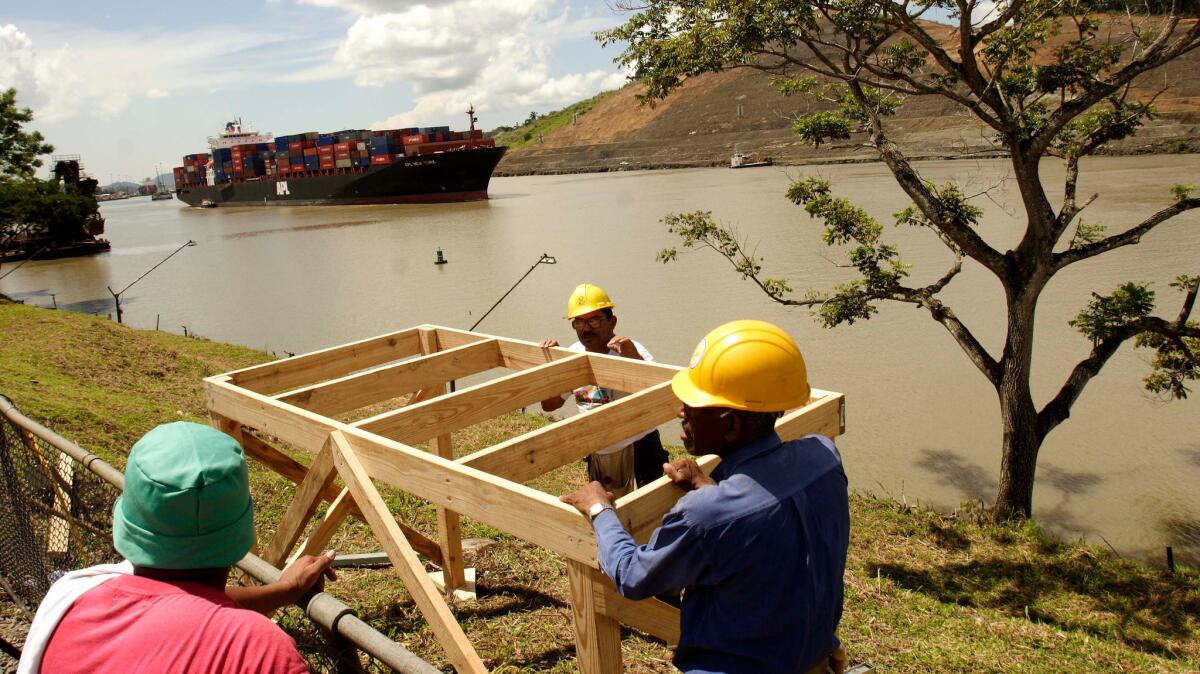From the archives:: Panama launches expansion of canal

- Share via
Reporting from Panama City — Lofty rhetoric, followed by explosions that blew off parts of a hillside, marked the beginning of a multibillion-dollar expansion of the Panama Canal on Monday.
The $5.25-billion expansion will accommodate a new class of huge ships capable of carrying more than twice the number of containers as the vessels that currently transit the waterway. Completion is set for 2014 to coincide with the 100th anniversary of the inauguration of the original canal.
Overwhelmingly approved by voters in October, the expansion is Panama’s bid to capture a bigger share of the booming global container trade, much of which bypasses the waterway because the supersized cargo ships can’t fit in the canal’s locks. The project is also a defensive move to co-opt proposals for competing waterways, including one in neighboring Nicaragua, analysts said.
U.S. President Carter, who authorized the transfer of the canal to Panama in a treaty he signed in 1977 with Panamanian strongman Omar Torrijos, attended the ceremony. Torrijos’ son, Panamanian President Martin Torrijos, lauded Carter’s courage and praised him as “an esteemed friend of Panama.”

After a two-decade transition, the canal was finally turned over to Panama on Dec. 31, 1999, as was the Canal Zone, a corridor 10 miles wide and 50 miles long. The Panama Canal Administration has drawn praise from international observers on its management of the canal since the turnover.
Carter’s initiative was criticized by his successor, Ronald Reagan, and may have been a factor in Carter’s unsuccessful 1980 reelection bid. But Carter has received generally high marks from analysts for generating goodwill among Latin American neighbors and for avoiding conflict over control of the canal.
“You demonstrated extraordinary personal courage in committing yourself to hand over the Panama Canal and in dismantling the colonial structure installed in the center of our territory,” President Torrijos told Carter.
Rumors had floated that Carter might not attend the ceremony in protest of the recent election of Pedro Miguel Gonzalez as president of Panama’s National Assembly. Gonzalez was indicted in 1995 in a Washington federal court in connection with the May 1992 murder of U.S. soldier Zak Hernandez in the Canal Zone.
Gonzalez is still wanted in the U.S., and the State Department has criticized Gonzalez’s election. U.S. government sources who asked not to be identified said Gonzalez’s assembly leadership might even block the pending U.S.-Panama free trade agreement.
Joining Carter at the event were regional presidents, including Colombia’s Alvaro Uribe, Honduras’ Manuel Zelaya, Nicaragua’s Daniel Ortega and El Salvador’s Elias Antonio Saca. Jose Miguel Inzulsa, secretary-general of the Organization of American States, also was among an estimated 40,000 people at the ceremony.
When complete, the expanded canal will accommodate ships capable of carrying 12,000 containers, up from a maximum 5,000 containers.
A 5-mile bypass on the Pacific side of the current canal is a central part of the expansion. So are two new sets of locks that will measure 1,400 feet long and 180 feet wide. The current locks are nearly 1,000 feet long and 110 feet wide. The new locks will also have a 50-foot draft, compared with the current 39 feet.
One of the technical innovations of the new design is that 60% of the water used to fill the locks will be recycled using special catch basins to be built with German technology. All the Gatun Lake water used to fill canal locks now is flushed out to sea.
NEWSLETTER: Get the day’s top headlines from Times Editor Davan Maharaj »
President Torrijos promised that the expanded canal would usher in a new age of economic growth “without poverty, without misery, without illiteracy and desperation.”
Francisco Miguez, coordinator of the expansion plan, said in an interview that the project would generate 8,000 direct jobs and an additional 35,000 indirect jobs among related supply and service firms.
Unlike the original canal project a century ago, when thousands of workers were imported from neighboring countries, Panama will supply all the required labor, Miguez said. Large-scale programs to produce skilled workers are underway, he said.
The Port of Long Beach, which with the Port of Los Angeles handles two-thirds of all West Coast trade, does not foresee the expanded canal as a threat to its business.
“We’re projecting within the next 10 or 15 years a doubling or tripling of our cargo, so if some of it goes through the canal, it may not affect the port,” said Art Wong, spokesman for the Port of Long Beach.
More to Read
Sign up for Essential California
The most important California stories and recommendations in your inbox every morning.
You may occasionally receive promotional content from the Los Angeles Times.











